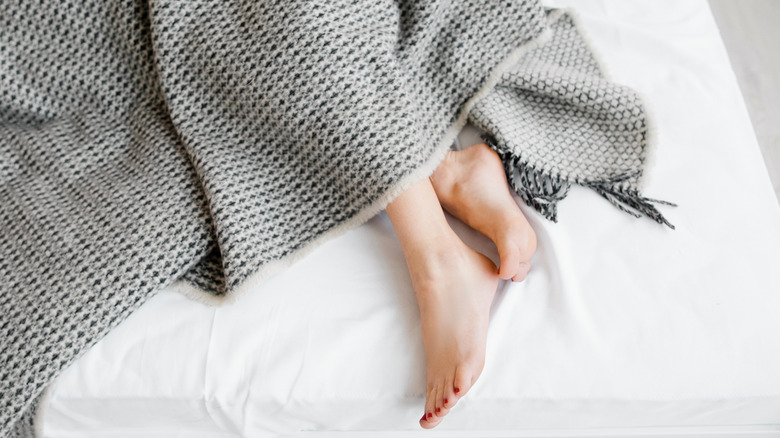What Does It Really Mean When Your Legs Move In Your Sleep
You may talk in your sleep sometimes, and you might occasionally move your legs during your sleep during a nightmare or when you change positions. However, if you happen to wake up tired regularly, and there is not anything else causing your exhaustion, you could have a sleep disorder that you might not have heard of before. Restless Legs Syndrome, also known as Willis-Ekbom disease, involves nocturnal lower limb movement (via Sleep Foundation). The syndrome, which is both a neurological sensory and movement disorder, causes an overwhelming urge to move your legs.
However, Restless Legs Syndrome might not be the reason you move your legs frequently while you catch some Zs. If your legs move a lot, it can cause daytime sleepiness, making it a problem that could have a solution (via WebMD). It could be something called Periodic Limb Movement Disorder (PLMD), which is often linked to Restless Legs Syndrome. However, these two conditions are not the same and it is essential to know which one you have (or both) so you can get the proper treatment and hopefully some relief.
Here's what you need to know about Periodic Limb Movement Disorder
The main thing that sets Periodic Limb Movement Disorder (PLMD) apart from Restless Legs Syndrome (RLS) is the rhythmic nature of your legs' nocturnal movements. WebMD reported that repetitive rhythmic movements that occur every 20 to 40 seconds characterize the sleep disorder. During the night, you are not aware you are moving your legs. Interestingly, 80% of those who have PLMD also have RLS (via American Sleep Association).
PLMD can be either the primary or secondary sleep disorder you have, which is why it's crucial to get evaluated by your healthcare provider, who will likely order a sleep study (via Healthline). Diabetes, an iron deficiency, anemia, uremia, a spinal cord tumor or injury, sleep apnea or narcolepsy, medication, and withdrawal from medication may all be associated with secondary PLMD. Unfortunately, there is no known cause of primary PLMD.
While PLMD is not a life-threatening condition, it can affect your quality of life. Treatment options include medications that help reduce movements or ones that will keep the moving from disrupting your sleep. If you have secondary PLMD, treating the primary condition might resolve it. If you regularly feel tired during the day, and you cannot pinpoint a reason, be sure to let your doctor know. Hopefully, with the right diagnosis, you will be falling asleep and resting well in no time.

